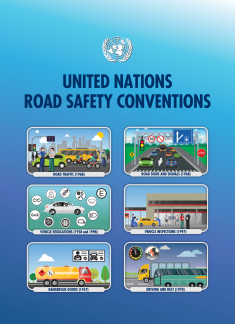
There are 59 United Nations legal instruments in the area of inland transport which are administered by the United Nations Economic Commission for Europe (UNECE). Of the 59 conventions, seven road safety instruments are considered to be priorities for accession:
- 1968 Convention on Road Traffic;
- 1968 Convention on Road Signs and Signals;
- 1958 Agreement concerning the Adoption of Harmonized Technical United Nations Regulations for Wheeled Vehicles, Equipment and Parts which can be Fitted and/or be Used on Wheeled Vehicles and the Conditions for Reciprocal Recognition of Approvals Granted on the Basis of these United Nations Regulations;
- 1997 Agreement concerning the Adoption of Uniform Conditions for Periodical Technical Inspections of Wheeled Vehicles;
- 1998 Agreement concerning the Establishing of Global Technical Regulations for Wheeled Vehicles, Equipment and Parts;
- 1957 Agreement concerning the International Carriage of Dangerous Goods by Road (ADR);
- 1970 European Agreement concerning the Work of Crews of Vehicles Engage in International Road Transport (AETR).
The conventions serve as a foundation for states to build national legal frameworks which prevent death and injuries from road traffic crashes. Road safety governance is above all about the political will to create and carry out a national strategy and programme. The United Nations General Assembly resolutions on «Improving global road safety» encourage all Member States to accede to the conventions and agreements.
Conventions des Nations Unies dans le domaine de la sécurité routière (French version)
Convenções das Nações Unidas sobre segurança rodoviária (Portugese version)
Convenciones de las Naciones Unidas sobre seguridad vial (Spanish version)


